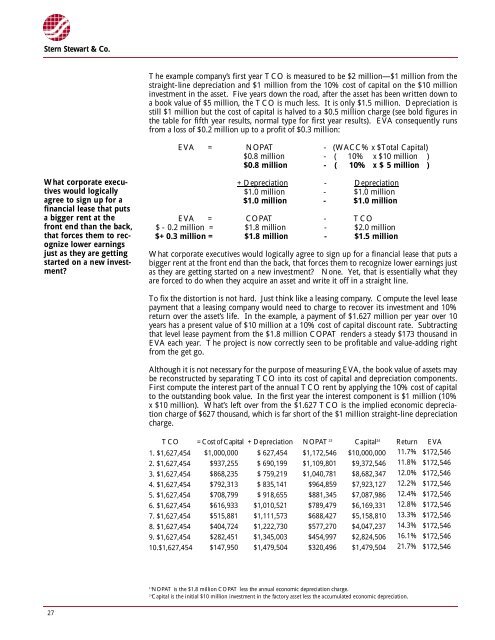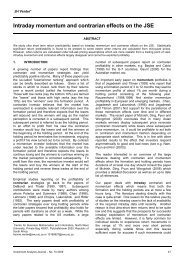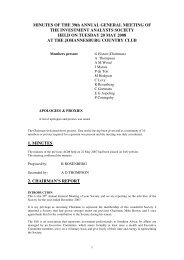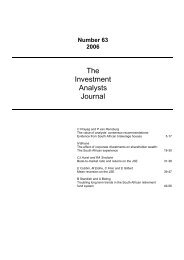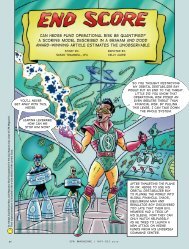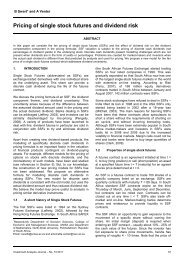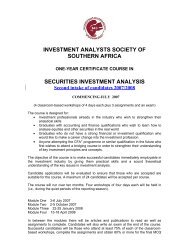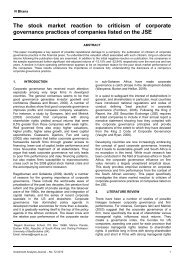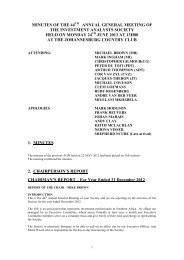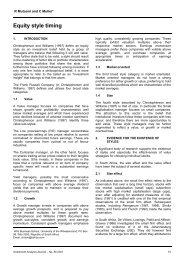Accounting is Broken - Investment Analysts Journal
Accounting is Broken - Investment Analysts Journal
Accounting is Broken - Investment Analysts Journal
You also want an ePaper? Increase the reach of your titles
YUMPU automatically turns print PDFs into web optimized ePapers that Google loves.
Stern Stewart & Co.<br />
The example company’s first year TCO <strong>is</strong> measured to be $2 million—$1 million from the<br />
straight-line depreciation and $1 million from the 10% cost of capital on the $10 million<br />
investment in the asset. Five years down the road, after the asset has been written down to<br />
a book value of $5 million, the TCO <strong>is</strong> much less. It <strong>is</strong> only $1.5 million. Depreciation <strong>is</strong><br />
still $1 million but the cost of capital <strong>is</strong> halved to a $0.5 million charge (see bold figures in<br />
the table for fifth year results, normal type for first year results). EVA consequently ru n s<br />
f rom a loss of $0.2 million up to a profit of $0.3 million:<br />
E VA = NOPAT - ( WACC% x $Total Capital)<br />
$0.8 million - ( 10% x $10 million )<br />
$0.8 million - ( 10% x $ 5 million )<br />
What corporate executives<br />
would logically<br />
a g ree to sign up for a<br />
financial lease that puts<br />
a bigger rent at the<br />
f ront end than the back,<br />
that forces them to re c-<br />
ognize lower earn i n g s<br />
just as they are getting<br />
s t a rted on a new investm<br />
e n t ?<br />
+ Depre c i a t i o n - D e p re c i a t i o n<br />
$1.0 million - $1.0 million<br />
$1.0 million - $1.0 million<br />
E VA = COPAT - TCO<br />
$ - 0.2 million = $1.8 million - $2.0 million<br />
$+ 0.3 million = $1.8 million - $1.5 million<br />
What corporate executives would logically agree to sign up for a financial lease that puts a<br />
bigger rent at the front end than the back, that forces them to recognize lower earnings just<br />
as they are getting started on a new investment? None. Yet, that <strong>is</strong> essentially what they<br />
a re forced to do when they acquire an asset and write it off in a straight line.<br />
To fix the d<strong>is</strong>tortion <strong>is</strong> not hard. Just think like a leasing company. Compute the level lease<br />
payment that a leasing company would need to charge to recover its investment and 10%<br />
re t u rn over the asset’s life. In the example, a payment of $1.627 million per year over 10<br />
years has a present value of $10 million at a 10% cost of capital d<strong>is</strong>count rate. Subtracting<br />
that level lease payment from the $1.8 million COPAT renders a steady $173 thousand in<br />
E VA each year. The project <strong>is</strong> now correctly seen to be profitable and value-adding right<br />
f rom the get go.<br />
Although it <strong>is</strong> not necessary for the purpose of measuring EVA, the book value of assets may<br />
be re c o n s t ructed by separating TCO into its cost of capital and depreciation components.<br />
First compute the interest part of the annual TCO rent by applying the 10% cost of capital<br />
to the outstanding book value. In the first year the interest component <strong>is</strong> $1 million (10%<br />
x $10 million). What’s left over from the $1.627 TCO <strong>is</strong> the implied economic depre c i a-<br />
tion charge of $627 thousand, which <strong>is</strong> far short of the $1 million straight-line depre c i a t i o n<br />
c h a rg e .<br />
TCO = Cost of Capital + Depreciation NOPAT 23 C a p i t a l 24 R e t u rn EVA<br />
$1,000,000 $ 627,454 $1,172,546 $10,000,000 11.7%<br />
$937,255 $ 690,199 $1,109,801 $9,372,546 11.8%<br />
$868,235 $ 759,219 $1,040,781 $8,682,347 12.0%<br />
$792,313 $ 835,141 $964,859 $7,923,127 12.2%<br />
$708,799 $ 918,655 $881,345 $7,087,986 12.4%<br />
$616,933 $1,010,521 $789,479 $6,169,331 12.8%<br />
$515,881 $1,111,573 $688,427 $5,158,810 13.3%<br />
$404,724 $1,222,730 $577,270 $4,047,237 14.3%<br />
$282,451 $1,345,003 $454,997 $2,824,506 16.1%<br />
$147,950 $1,479,504 $320,496 $1,479,504 21.7%<br />
1. $1,627,454<br />
2. $1,627,454<br />
3. $1,627,454<br />
4. $1,627,454<br />
5. $1,627,454<br />
6. $1,627,454<br />
7. $1,627,454<br />
8. $1,627,454<br />
9. $1,627,454<br />
10.$1,627,454<br />
$172,546<br />
$172,546<br />
$172,546<br />
$172,546<br />
$172,546<br />
$172,546<br />
$172,546<br />
$172,546<br />
$172,546<br />
$172,546<br />
2 3<br />
N O PAT <strong>is</strong> the $1.8 million COPAT less the annual economic depreciation charg e .<br />
2 4<br />
Capital <strong>is</strong> the initial $10 million investment in the factory asset less the accumulated economic depre c i a t i o n .<br />
27


